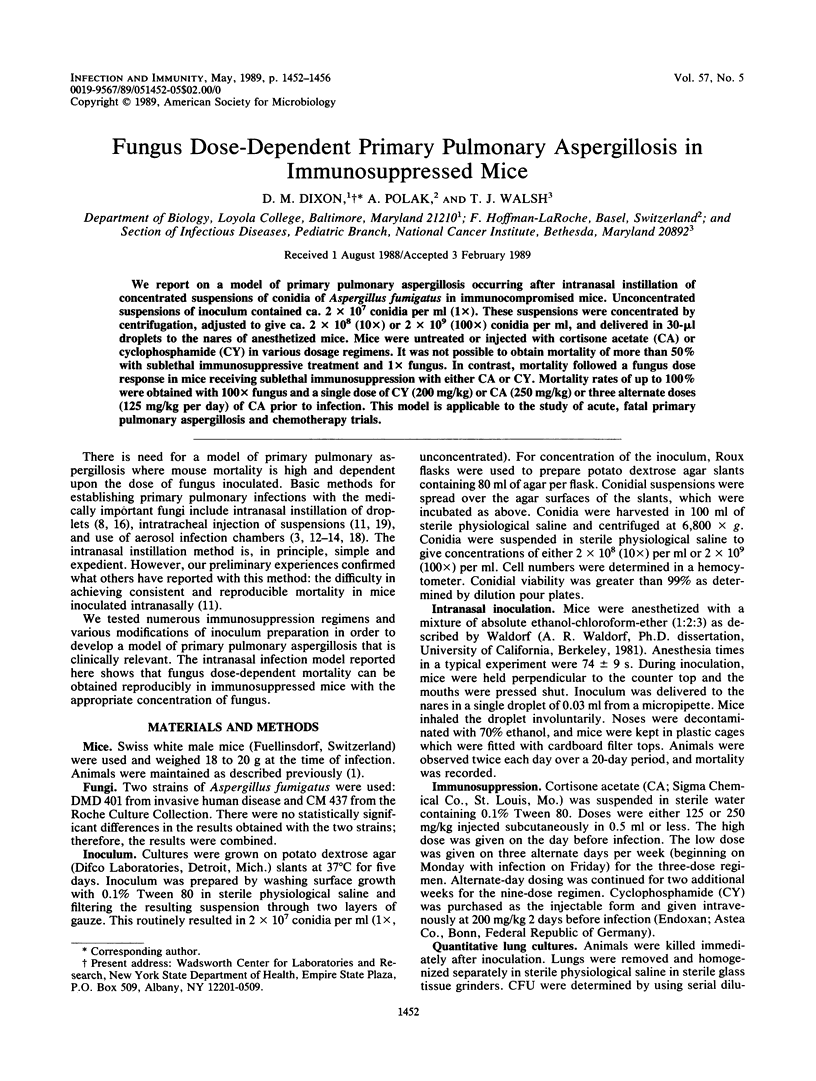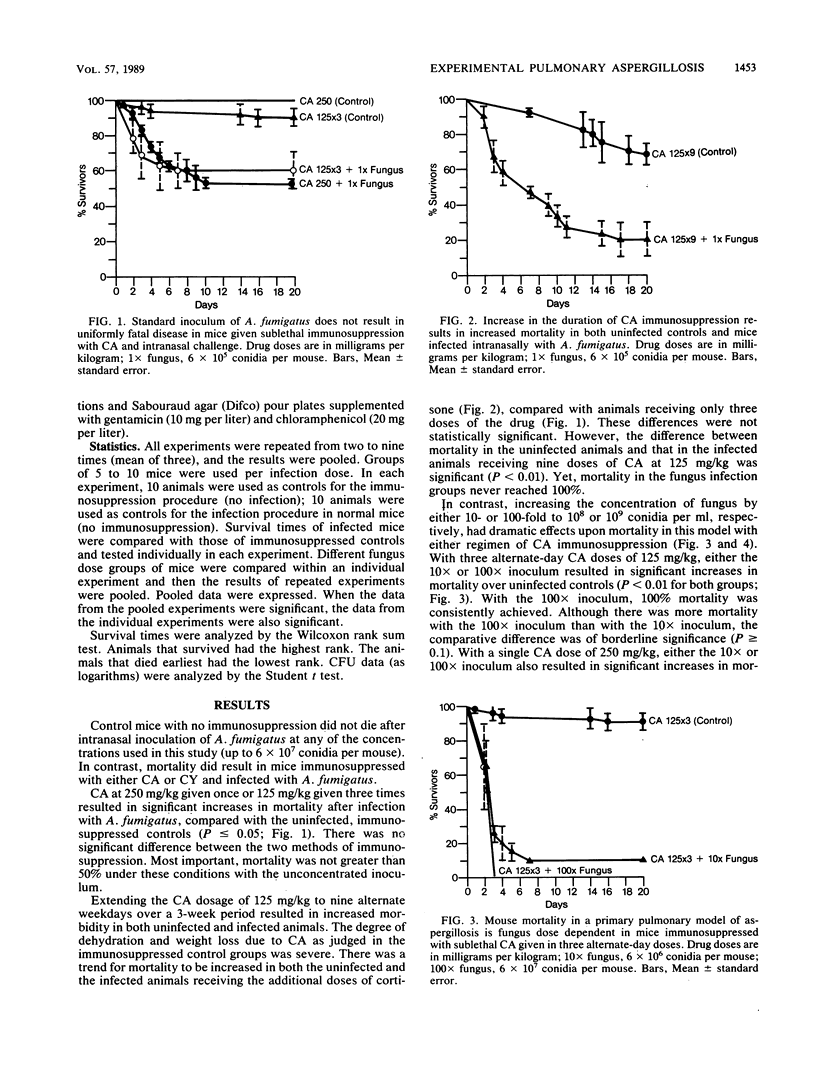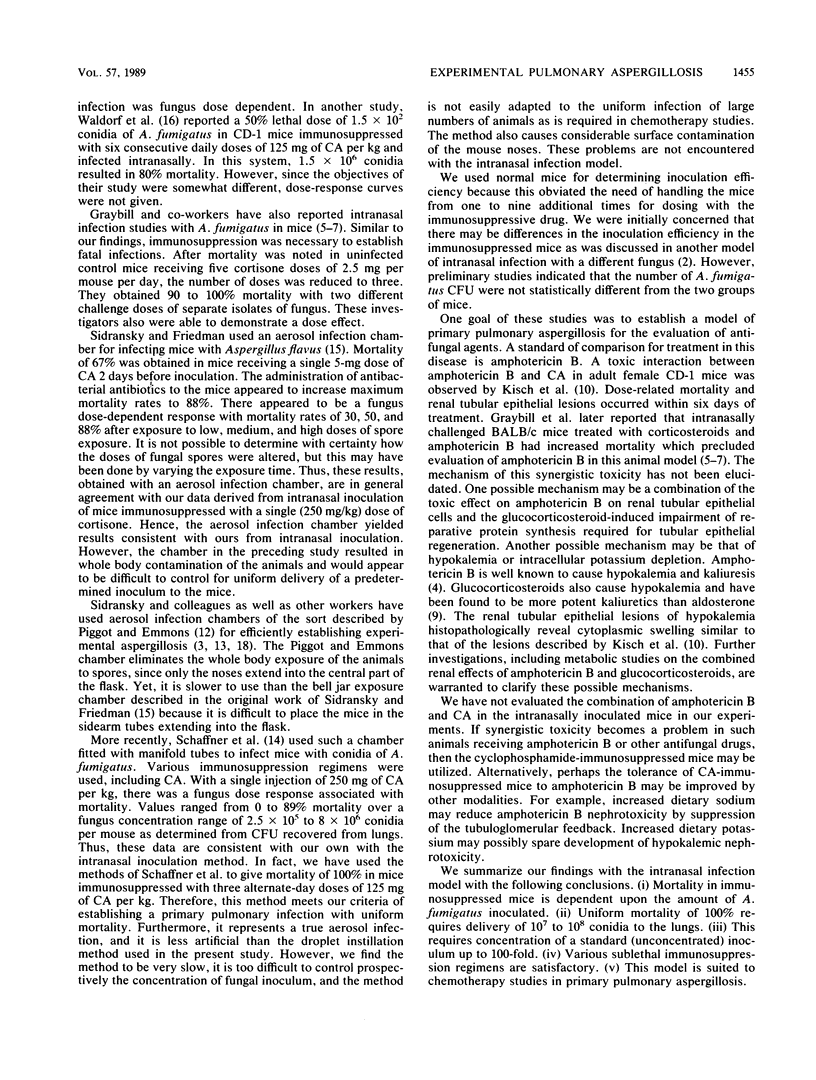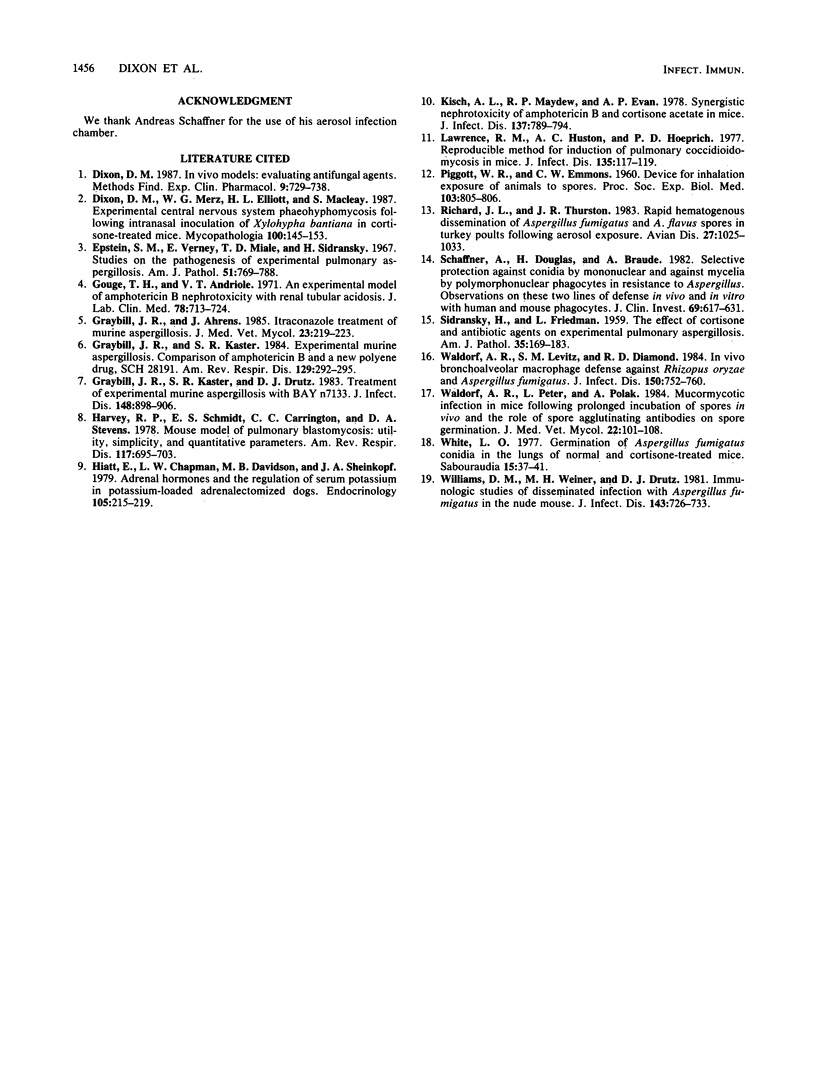Abstract
We report on a model of primary pulmonary aspergillosis occurring after intranasal instillation of concentrated suspensions of conidia of Aspergillus fumigatus in immunocompromised mice. Unconcentrated suspensions of inoculum contained ca. 2 x 10(7) conidia per ml (1x). These suspensions were concentrated by centrifugation, adjusted to give ca. 2 x 10(8) (10x) or 2 x 10(9) (100x) conidia per ml, and delivered in 30-microliters droplets to the nares of anesthetized mice. Mice were untreated or injected with cortisone acetate (CA) or cyclophosphamide (CY) in various dosage regimens. It was not possible to obtain mortality of more than 50% with sublethal immunosuppressive treatment and 1x fungus. In contrast, mortality followed a fungus dose response in mice receiving sublethal immunosuppression with either CA or CY. Mortality rates of up to 100% were obtained with 100x fungus and a single dose of CY (200 mg/kg) or CA (250 mg/kg) or three alternate doses (125 mg/kg per day) of CA prior to infection. This model is applicable to the study of acute, fatal primary pulmonary aspergillosis and chemotherapy trials.
Full text
PDF




Selected References
These references are in PubMed. This may not be the complete list of references from this article.
- Dixon D. M. In vivo models: evaluating antifungal agents. Methods Find Exp Clin Pharmacol. 1987 Nov;9(11):729–738. [PubMed] [Google Scholar]
- Dixon D. M., Merz W. G., Elliott H. L., Macleay S. Experimental central nervous system phaeohyphomycosis following intranasal inoculation of Xylohypha bantiana in cortisone-treated mice. Mycopathologia. 1987 Dec;100(3):145–153. doi: 10.1007/BF00437040. [DOI] [PubMed] [Google Scholar]
- Epstein S. M., Verney E., Miale T. D., Sidransky H. Studies on the pathogenesis of experimental pulmonary aspergillosis. Am J Pathol. 1967 Nov;51(5):769–788. [PMC free article] [PubMed] [Google Scholar]
- Gouge T. H., Andriole V. T. An experimental model of amphotericin B nephrotoxicity with renal tubular acidosis. J Lab Clin Med. 1971 Nov;78(5):713–724. [PubMed] [Google Scholar]
- Graybill J. R., Ahrens J. Itraconazole treatment of murine aspergillosis. Sabouraudia. 1985 Jun;23(3):219–223. doi: 10.1080/00362178585380321. [DOI] [PubMed] [Google Scholar]
- Graybill J. R., Kaster S. R., Drutz D. J. Treatment of experimental murine aspergillosis with BAY n7133. J Infect Dis. 1983 Nov;148(5):898–906. doi: 10.1093/infdis/148.5.898. [DOI] [PubMed] [Google Scholar]
- Graybill J. R., Kaster S. R. Experimental murine aspergillosis. Comparison of amphotericin B and a new polyene antifungal drug, SCH 28191. Am Rev Respir Dis. 1984 Feb;129(2):292–295. [PubMed] [Google Scholar]
- Harvey R. P., Schmid E. S., Carrington C. C., Stevens D. A. Mouse model of pulmonary blastomycosis: utility, simplicity, and quantitative parameters. Am Rev Respir Dis. 1978 Apr;117(4):695–703. doi: 10.1164/arrd.1978.117.4.695. [DOI] [PubMed] [Google Scholar]
- Hiatt N., Chapman L. W., Davidson M. B., Sheinkopf J. A. Adrenal hormones and the regulation of serum potassium in potassium-loaded adrenalectomized dogs. Endocrinology. 1979 Jul;105(1):215–219. doi: 10.1210/endo-105-1-215. [DOI] [PubMed] [Google Scholar]
- Kisch A. L., Maydew R. P., Evan A. P. Synergistic nephrotoxicity of amphotericin B and cortisone acetate in mice. J Infect Dis. 1978 Jun;137(6):789–794. doi: 10.1093/infdis/137.6.789. [DOI] [PubMed] [Google Scholar]
- Lawrence R. M., Huston A. C., Hoeprich P. D. Reproducible method for induction of pulmonary coccidioidomycosis in mice. J Infect Dis. 1977 Jan;135(1):117–119. doi: 10.1093/infdis/135.1.117. [DOI] [PubMed] [Google Scholar]
- PIGGOTT W. R., EMMONS C. W. Device for inhalation exposure of animals to spores. Proc Soc Exp Biol Med. 1960 Apr;103:805–806. doi: 10.3181/00379727-103-25677. [DOI] [PubMed] [Google Scholar]
- Richard J. L., Thurston J. R. Rapid hematogenous dissemination of Aspergillus fumigatus and A. flavus spores in turkey poults following aerosol exposure. Avian Dis. 1983 Oct-Dec;27(4):1025–1033. [PubMed] [Google Scholar]
- SIDRANSKY H., FRIEDMAN L. The effect of cortisone and antibiotic agents on experimental pulmonary aspergillosis. Am J Pathol. 1959 Jan-Feb;35(1):169–183. [PMC free article] [PubMed] [Google Scholar]
- Schaffner A., Douglas H., Braude A. Selective protection against conidia by mononuclear and against mycelia by polymorphonuclear phagocytes in resistance to Aspergillus. Observations on these two lines of defense in vivo and in vitro with human and mouse phagocytes. J Clin Invest. 1982 Mar;69(3):617–631. doi: 10.1172/JCI110489. [DOI] [PMC free article] [PubMed] [Google Scholar]
- Waldorf A. R., Levitz S. M., Diamond R. D. In vivo bronchoalveolar macrophage defense against Rhizopus oryzae and Aspergillus fumigatus. J Infect Dis. 1984 Nov;150(5):752–760. doi: 10.1093/infdis/150.5.752. [DOI] [PubMed] [Google Scholar]
- Waldorf A. R., Peter L., Polak A. Mucormycotic infection in mice following prolonged incubation of spores in vivo and the role of spore agglutinating antibodies on spore germination. Sabouraudia. 1984;22(2):101–108. doi: 10.1080/00362178485380171. [DOI] [PubMed] [Google Scholar]
- White L. O. Germination of Aspergillus fumigatus conidia in the lungs of normal and cortisone-treated mice. Sabouraudia. 1977 Mar;15(1):37–41. [PubMed] [Google Scholar]
- Williams D. M., Weiner M. H., Drutz D. J. Immunologic studies of disseminated infection with Aspergillus fumigatus in the nude mouse. J Infect Dis. 1981 May;143(5):726–733. doi: 10.1093/infdis/143.5.726. [DOI] [PubMed] [Google Scholar]


